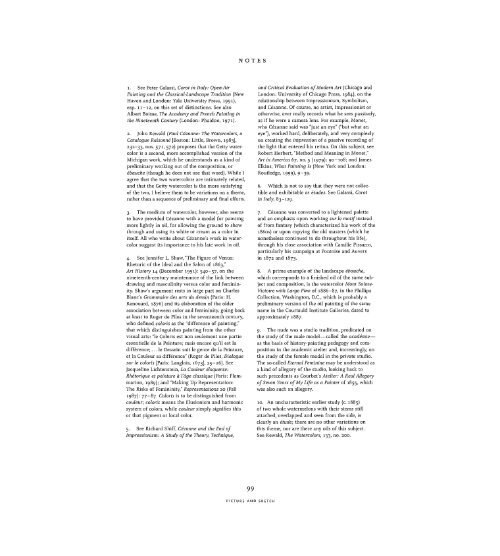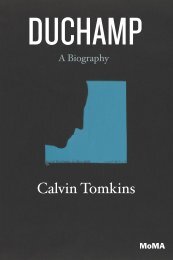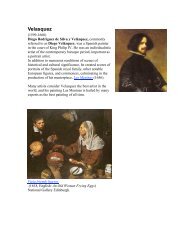Still Life in Watercolors
qbj8dgc
qbj8dgc
- No tags were found...
You also want an ePaper? Increase the reach of your titles
YUMPU automatically turns print PDFs into web optimized ePapers that Google loves.
NOTES<br />
1. See Peter Galassi, Corot <strong>in</strong> Italy: Open-Air<br />
Pa<strong>in</strong>t<strong>in</strong>g and the Classical-Landscape Tradition (New<br />
Haven and London: Yale University Press, 1991),<br />
esp. 11-12, on this set of dist<strong>in</strong>ctions. See also<br />
Albert Boime, The Academy and French Pa<strong>in</strong>t<strong>in</strong>g <strong>in</strong><br />
the N<strong>in</strong>eteenth Century (London: Phaidon, 1971).<br />
2. John Rewald (Paul Cezanne: The <strong>Watercolors</strong>, a<br />
Catalogue Raisonne [Boston: Little, Brown, 1983],<br />
232-33, nos. 571, 572) proposes that the Getty watercolor<br />
is a second, more accomplished version of the<br />
Michigan work, which he understands as a k<strong>in</strong>d of<br />
prelim<strong>in</strong>ary work<strong>in</strong>g out of the composition, or<br />
ebauche (though he does not use that word). While I<br />
agree that the two watercolors are <strong>in</strong>timately related,<br />
and that the Getty watercolor is the more satisfy<strong>in</strong>g<br />
of the two, I believe them to be variations on a theme,<br />
rather than a sequence of prelim<strong>in</strong>ary and f<strong>in</strong>al efforts.<br />
3. The medium of watercolor, however, also seems<br />
to have provided Cezanne with a model for pa<strong>in</strong>t<strong>in</strong>g<br />
more lightly <strong>in</strong> oil, for allow<strong>in</strong>g the ground to show<br />
through and us<strong>in</strong>g its white or cream as a color <strong>in</strong><br />
itself. All who write about Cezanne's work <strong>in</strong> watercolor<br />
suggest its importance to his late work <strong>in</strong> oil.<br />
4. See Jennifer L. Shaw, "The Figure of Venus:<br />
Rhetoric of the Ideal and the Salon of 1863,"<br />
Art History 14 (December 1991): 540-57, on the<br />
n<strong>in</strong>eteenth-century ma<strong>in</strong>tenance of the l<strong>in</strong>k between<br />
draw<strong>in</strong>g and mascul<strong>in</strong>ity versus color and fem<strong>in</strong><strong>in</strong>ity.<br />
Shaw's argument rests <strong>in</strong> large part on Charles<br />
Blanc's Grammaire des arts du dess<strong>in</strong> (Paris: H.<br />
Renouard, 1876) and its elaboration of the older<br />
association between color and fem<strong>in</strong><strong>in</strong>ity, go<strong>in</strong>g back<br />
at least to Roger de Piles <strong>in</strong> the seventeenth century,<br />
who def<strong>in</strong>ed colons as the "difference of pa<strong>in</strong>t<strong>in</strong>g,"<br />
that which dist<strong>in</strong>guishes pa<strong>in</strong>t<strong>in</strong>g from the other<br />
visual arts: "le Coloris est non seulement une partie<br />
essentielle de la Pe<strong>in</strong>ture; mais encore qu'il est la<br />
difference;... le Desse<strong>in</strong> soit le genre de la Pe<strong>in</strong>ture,<br />
et la Couleur sa difference" (Roger de Piles, Dialogue<br />
sur le colons [Paris: Langlois, 1673], 2 5~ 2 6)- See<br />
Jacquel<strong>in</strong>e Lichtenste<strong>in</strong>, La Couleur eloquente:<br />
Rhetorique et pe<strong>in</strong>ture a I'age classique (Paris: Flammarion,<br />
1989); and "Mak<strong>in</strong>g Up Representation:<br />
The Risks of Fem<strong>in</strong><strong>in</strong>ity," Representations 20 (Fall<br />
1987): 77-87. Coloris is to be dist<strong>in</strong>guished from<br />
couleur, colons means the illusionism and harmonic<br />
system of colors, while couleur simply signifies this<br />
or that pigment or local color.<br />
5. See Richard Shiff, Cezanne and the End of<br />
Impressionism: A Study of the Theory, Technique,<br />
and Critical Evaluation of Modern Art (Chicago and<br />
London: University of Chicago Press, 1984), on the<br />
relationship between Impressionism, Symbolism,<br />
and Cezanne. Of course, no artist, Impressionist or<br />
otherwise, ever really records what he sees passively,<br />
as if he were a camera lens. For example, Monet,<br />
who Cezanne said was "just an eye" ("but what an<br />
eye"), worked hard, deliberately, and very complexly<br />
on creat<strong>in</strong>g the impression of a passive record<strong>in</strong>g of<br />
the light that entered his ret<strong>in</strong>a. On this subject, see<br />
Robert Herbert, "Method and Mean<strong>in</strong>g <strong>in</strong> Monet,"<br />
Art <strong>in</strong> America 67, no. 5 (1979): 90-108; and James<br />
Elk<strong>in</strong>s, What Pa<strong>in</strong>t<strong>in</strong>g Is (New York and London:<br />
Routledge, 1999), 9-39.<br />
6. Which is not to say that they were not collectible<br />
and exhibitable as etudes. See Galassi, Corot<br />
<strong>in</strong> Italy, 83-129.<br />
7. Cezanne was converted to a lightened palette<br />
and an emphasis upon work<strong>in</strong>g sur le motif <strong>in</strong>stead<br />
of from fantasy (which characterized his work of the<br />
i86os) or upon copy<strong>in</strong>g the old masters (which he<br />
nonetheless cont<strong>in</strong>ued to do throughout his life),<br />
through his close association with Camille Pissarro,<br />
particularly his campaign at Pontoise and Auvers<br />
<strong>in</strong> 1872 and 1873.<br />
8. A prime example of the landscape ebauche,<br />
which corresponds to a f<strong>in</strong>ished oil of the same subject<br />
and composition, is the watercolor Mont Sa<strong>in</strong>te-<br />
Victoire with Large P<strong>in</strong>e of 1886-87, <strong>in</strong> the Phillips<br />
Collection, Wash<strong>in</strong>gton, D.C., which is probably a<br />
prelim<strong>in</strong>ary version of the oil pa<strong>in</strong>t<strong>in</strong>g of the same<br />
name <strong>in</strong> the Courtauld Institute Galleries, dated to<br />
approximately 1887.<br />
9. The nude was a studio tradition, predicated on<br />
the study of the male model—called the academie—<br />
as the basis of history-pa<strong>in</strong>t<strong>in</strong>g pedagogy and composition<br />
<strong>in</strong> the academic atelier and, <strong>in</strong>creas<strong>in</strong>gly, on<br />
the study of the female model <strong>in</strong> the private studio.<br />
The so-called Eternal Fem<strong>in</strong><strong>in</strong>e may be understood as<br />
a k<strong>in</strong>d of allegory of the studio, look<strong>in</strong>g back to<br />
such precedents as Courbet's Atelier: A Real Allegory<br />
of Seven Years of My <strong>Life</strong> as a Pa<strong>in</strong>ter of 1855, which<br />
was also such an allegory.<br />
10. An uncharacteristic earlier study (c. 1885)<br />
of two whole watermelons with their stems still<br />
attached, overlapped and seen from the side, is<br />
clearly an etude; there are no other variations on<br />
this theme, nor are there any oils of this subject.<br />
See Rewald, The <strong>Watercolors</strong>, 133, no. 200.<br />
99<br />
PICTURE AND SKETCH




